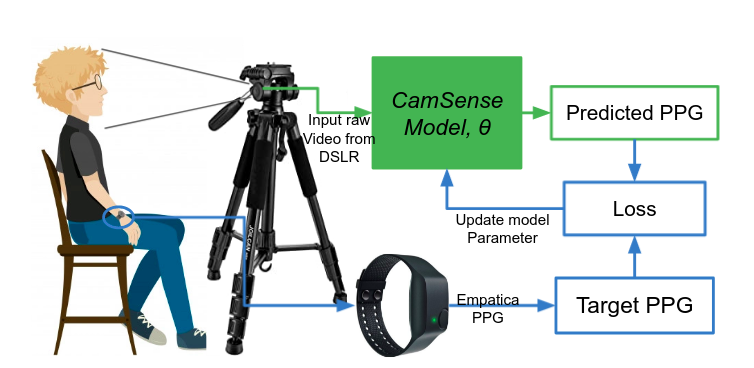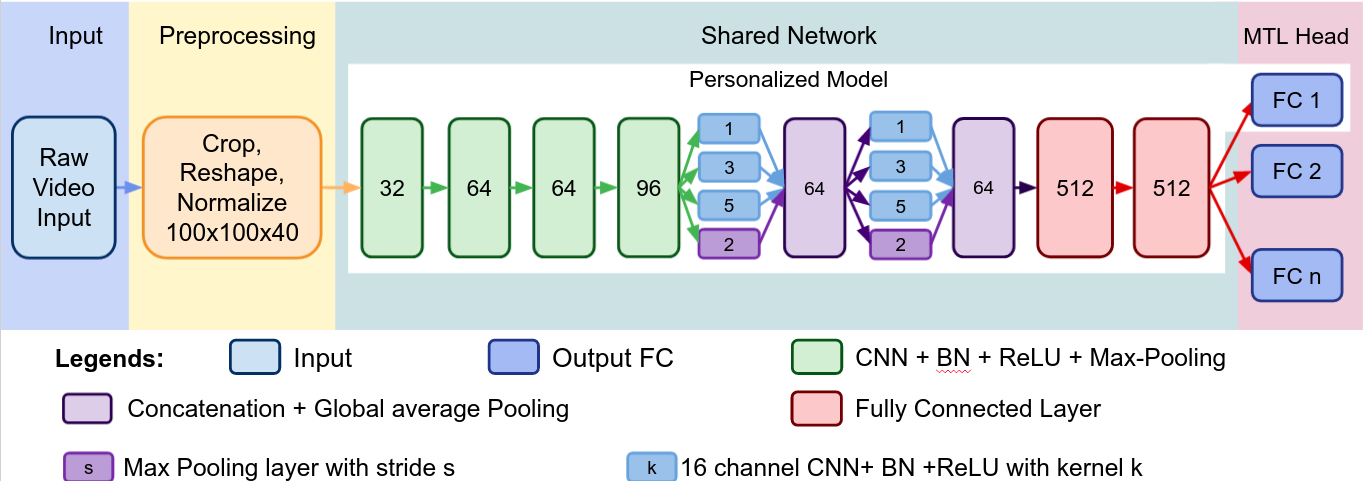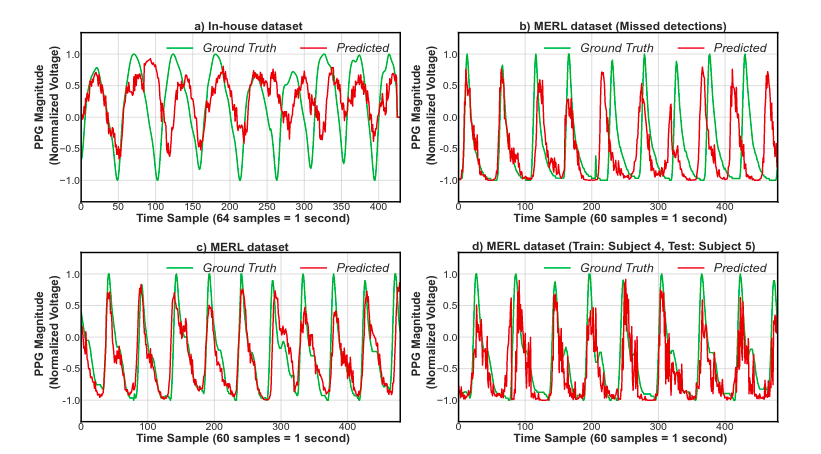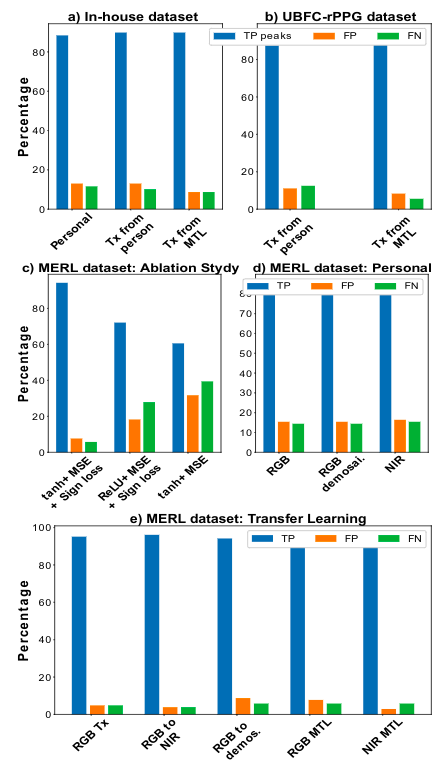In this research work, We aim to implement multi task learning based neural network to extract robust PPG from the Heart Rate.
This cite contains the codes to reproduce the results, collected data description, and sample analysis resutls.
Remote Photoplythysmograpy (rPPG) systems enable contactless heart activities (heart rate, heart rate variability) monitoring by estimating Photoplethysmogram (PPG) signal, blood's volumetric variation in the skin tissues, leveraging the occurred diffused reflection from the exposed skin in skin video. They can primarily monitor heart activities using off-the-shelf video sensors while ensuring the safety of concerned individuals during contagious diseases. However, developing the rPPG systems is challenging due to the marginal presence of PPG signal in the video stream, data variations, limited and noisy rPPG data. In this regard, we propose an end-to-end deep learning-based approach for camera-based contactless sensing "CamSense" for recovering PPG signals from consecutive raw video frames. Firstly, we design and validate a personalized model to bypass data variation and noise across data collection with a modified objective function under realistic settings. Secondly, we explore and design multi-task learning (MTL) network to address the rPPG data variabilities for learning generalized rPPG representations. We also propose a transfer learning approach that integrates an efficient weight initialization to scale the rPPG systems under different domains and settings for fast and generalized training and inferences. Finally, we propose a new 'in-house' rPPG dataset containing multiple RGB videos and corresponding PPG ground truth for end-end rPPG network training. We evaluate CamSense on two public datasets and our 'in-house' dataset across multiple subjects and heterogeneous camera sensors such as DSLR and near-infrared sensors with different ground truth provider PPG sensors (wrist, finger) to showcase its' generalizability. We further validate our components' design choices by performing ablation studies using different settings. Our developed model approximates accurate PPG signals with an average root mean square error (RMSE) of
rPPG (remote Photoplethysmogram) signal measures the volumetric variation in the uncovered skin tissues from the video streams. This blood variation in the skin is the direct result of rhythmic heart activities.
Figure: Our Overview of data collection and model development.
Figure: Utilization of the Multi head network to learn from multiple video simultaneous in the CamSense. The Multi head allows the model to disregards the data alignment issues and encounter sensor heterogeneity. The architecture also allows us to combine data from multiple sources.
Figure: Sample result of PPG approximation using the CamSense Network.
Figure: Sample result of PPG approximation using the transfer learning using the base CamSense Network.
Figure: Overall result summary using the CamSense Model and its design choices.
To collect video with enough PPG signal and well-aligned PPG, we collect simultaneous PPG and video sensor data. We collected HD video using RGB stationery(in a stand) DSLR (Canon D3500) at 30 fps in a laboratory setup under artificial light for 5 minutes while each volunteer was sitting idly on a chair three feet away in front of the camera. Concurrently, Empatica E4 Wristwatch tracks the wrist PPG sampled at 64 Hz from volunteers’ dominant hand.To align the video and PPG data to the same time-stamp, we leveraged the event marker feature in the Empatica E4.During that, the volunteers count to ten for 10 seconds. We identified the exact position of the event marker press of Empatica E4 by locating event marker light at particular video frames. The Empatica E4 locates the exact PPG position for the event markers pressed. This allows us to align PPG andvideo with an error margin of 1/30 seconds.
The dataset consists of two females, six males volunteers. Our dataset has included person heterogeneity such as sex, facial hair, fitness level, and spectacles usage. Two male volunteers provided data with and without a beard and glass. All subjects are healthy and have no known medical condition having HR ranges from 50 BPM to 95 BPM. In RGB video times, our dataset suppressed both public datasets, and suitable for developing generalized DL models. Moreover, the in-house dataset introduces heterogeneity by placing the PPG sensor at the wrist.
| No of subs | Collections | Data Length | Data Variety |
|---|---|---|---|
| 9 | 14 | ~ 2 hours (~ 200K frames) | Regular, Gender, Light, Beard, Glass, Sensor, Distance |
We have received the kind consent of the volunteers to collect their data and followed instructional Review Board (IRB) protocol during the data collection.
Please contact us to get the access to rPPG data. Upon receiving request and agreement, we will share the drive link to download the videos and corresponding Empatica PPG signal. The instructions and python source code will also be provided to align the video with the PPG signal for training and validation.
@article{zahid2021camsense, title={CamSense: A Camera-Based Contact-less Heart Activity Monitoring}, author={Hasan, Zahid and Ramamurthy, Sreenivasan Ramasamy and Roy, Nirmalya}, journal={Smart Health}, year={2021}, publisher={Elsevier} }
MPSC-lab Format:
This MPSC-rPPG dataset was collected to capture facial video at high-resolution and frame per second (input) with simultaneous wrist PPG signal (ground truth). The dataset covers personal variances, background, skin tone, brightness variations. We believe, providing open access to the MPSC-rPPG dataset would enable development and validation for different PPG extraction methods, and thus data is made available. If you use these datasets for your research, please cite the following paper. You can find the dataset in the following website link. However, please do not use any subject's face/description in your presentation, report, or paper.
Access the dataset here.
Zahid Hasan, Sreenivasan Ramasamy Ramamurthy, Nirmalya Roy. CamSense: A Camera-Based Contact-less Heart Activity Monitoring, in Proceedings of the IEEE/ACM International Conference on Connected Health: Applications, Systems and Engineering Technologies (CHASE), Washington D.C. December 2021
The dataset contains RGB DSLR facial videos under artificial light from 3-6 feet distance. The subjects wear Empatica E4 Wristwatch during the video collection to track the PPG simultaneously. We align the vides and corresponding Empatica PPG signal with an error bound of 1/30 seconds by leveraging the Event Marker features of Empatica.
The two hours of rPPG data contain two females and six males who volunteered multiple times, covering heterogeneity such as sex, facial hair, fitness level, skin color, and spectacles usage in the dataset.




